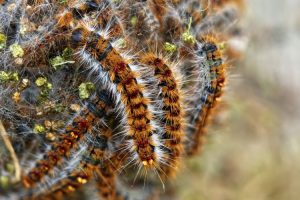Insect bites: Where do they come from and what can we do?
This article was written by Dr. Pleimes, a specialist in pediatrics, dermatology, and allergology.
Learn more about Dr. Pleimes here.
Insect bites are caused by stings or bites from various insect species, including mosquitoes, bees, wasps, fleas, lice, and bedbugs. Grass mites or ticks (which belong to arachnids) can also trigger skin reactions in your child. Our body reacts to the venom, saliva, other contact substances, or body parts of these insects.
Typically, this results in localized redness and slight swelling of the skin at the contact site. The severity of the reaction depends on the specific substances involved and the individual’s bodily response.
The most common local reactions are caused by mosquito bites. When a mosquito bites your child, the body reacts to the mosquito’s saliva, leading to a localized response that lasts from a few hours to a few days. Usually, small red spots a few millimeters in size appear around the bite site, sometimes with a small central welt. While some children may experience strong reactions at the bite site, mosquito bites are generally harmless, even for very young children and babies. Mosquito-borne diseases are rarely an issue in Germany, though this may differ when traveling abroad. For long-distance travel, it is advisable to gather information in advance (e.g., from the Tropical Institute, Robert Koch Institute, or Foreign Office).
Bee or wasp stings, which are also relatively common, cause a reaction to the venom injected with the sting. The local reaction is usually more pronounced, and the sting and its effects are significantly more painful than mosquito bites. Redness and swelling, often several centimeters in size but usually less than 10 cm in diameter, occur and typically begin to subside within 24 hours. Such reactions in your child are also harmless. However, stings in the mouth or throat or in cases of a true allergy can be dangerous. Itching and scratching can worsen local irritation and prolong the reaction.
Exaggerated local reactions to insect bites are relatively common, affecting up to 25% of the population. In these cases, the bite site may show redness exceeding 10 cm in diameter, accompanied by significant swelling, warmth, and pain that can persist for several days before subsiding. These reactions can sometimes be mistaken for a skin infection. Children with mosquito bites may also experience strong swelling and redness, often several centimeters in size, accompanied by more intense itching.
What can be done about mosquito bites and similar reactions?
Local cooling with cold packs from the refrigerator, gels, or moist compresses (e.g., soaked for a few minutes in saline solution approx. 1g of salt in 100ml of water or cold black tea) can alleviate local reactions in your baby or child. For severe reactions or scratched areas, a compress with an antiseptic like octenidine or polyhexanide can also help.
For individual mosquito bites in slightly older children, using special heat pens to briefly warm the skin can reduce the reaction.
Your doctor may additionally prescribe a topical cortisone preparation for a few days and, in cases of severe itching, an oral antihistamine. If pain occurs, such as after a wasp sting, a pain-relieving syrup like ibuprofen can be given. If a bee has stung and the stinger remains in the skin, it can be gently removed with a calm motion.
What if my child is allergic?
The venom from bees, wasps, and other insects like hornets or bumblebees contains certain components that can trigger a true allergic reaction in some individuals. This is rare for mosquito bites. After initial contact with the venom and the immune system storing information about it (sensitization), stronger allergic reactions can occur:
- Skin reactions in other areas (hives on the body)
- Airway constriction
- Circulatory reactions, possibly with vomiting
- In severe cases, a life-threatening allergic shock.
Approximately 3% of the population develops such reactions.
Important Note: If someone experiences symptoms beyond a local reaction, such as widespread hives, breathing difficulties, or vomiting after an insect sting, an emergency doctor should be called immediately. If the incident has already passed, a doctor should still be consulted to investigate a possible allergy and prescribe appropriate medication for an emergency kit in case of future reactions. Depending on the situation, specific immunotherapy (desensitization) may also be recommended to reduce the severity of future reactions. Stings in the mouth or throat should always prompt a call to emergency services if symptoms appear.
Fleas, lice, bedbugs, and other culprits
Fleas, often transmitted from animals to humans, show a typical bite pattern of multiple bites, often in clusters of three. These are commonly found on the legs but can also occur on other parts of the body, including areas covered by clothing.
Bedbug bites, on the other hand, are usually found on uncovered skin areas. They may appear in a line and can cause various reactions such as hives, papules, small blisters, or blood blisters. The redness is often more pronounced than flea bites, but the itching may occur later.
Recognizing Infestations:
- Fleas are often brought into the home by pets.
- Bedbugs are usually introduced after travel or through second-hand furniture. Addressing a bedbug infestation can be challenging and often requires professional help.
Grass mites live outdoors, particularly in dry meadows and grassy areas from March to October. Their larvae can bite, causing redness and irritation, especially on thin, sensitive skin. The bites can lead to intense itching for days or weeks, but the mites themselves remain outdoors, posing no risk of infection. Fresh bite sites should be disinfected and treated similarly to mosquito bites.
Tick bites in babies and young children
Ticks can sometimes be found on your child’s skin and should be removed as soon as possible. Use tweezers or a special tick remover to grip the tick close to the skin (at its head) and slowly pull it out. After removal, disinfect the bite site. The area around the bite should be monitored for a few weeks. If a fine red ring that gradually expands appears around the bite, this could indicate a Borrelia infection (erythema migrans). In such cases, consult your doctor to confirm the diagnosis and possibly prescribe antibiotics.
Sometimes it’s not even a bite or sting
In southern regions and parts of Germany, a caterpillar species called the oak processionary moth can be found near oak trees. The caterpillars develop into moths by July, but during their development in May and June, they carry fine hairs that easily break and release irritating substances upon contact. These can cause sting-like skin reactions at the contact sites.

Caterpillar hairs can also accumulate in leaves and the surrounding area of oak trees, causing reactions even beyond the caterpillar stage. Playing in such areas can lead to widespread sting-like reactions, known as caterpillar dermatitis, on exposed skin. The redness itches intensely and can persist for days. Your pediatrician may prescribe a mild cortisone cream to reduce inflammation and an antihistamine to alleviate itching.
Prevention is better than cure
Insect repellents can provide additional protection. While some products are approved for use in children as young as two months, they should be used sparingly, especially for very young children and infants.
Outdoors, mosquito nets are a better option depending on the situation. Fly screens on windows can prevent mosquitoes from entering your baby’s sleeping area. Avoid walking barefoot on grass, as grass mites, ticks, bees, and many types of wasps can be found on or near the ground.




Comments (0)